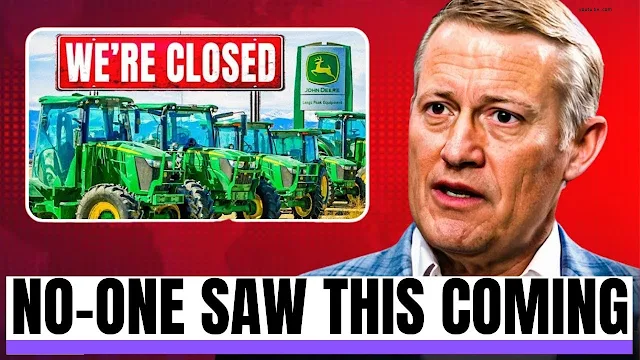John Deere has frozen all U.S. manufacturing operations indefinitely—the first total production shutdown in its 186-year history—sparking panic across America's agricultural heartland. Style on Main reveals collapsing tractor demand, supply chain chaos, and a looming UAW strike forced the drastic move, idling 18 factories and 30,000 workers. With farmers facing harvest season without equipment repairs and dealers scrambling, the freeze threatens to cripple food production during peak season. As shares plummet 14% pre-market, analysts warn this could trigger a domino effect in the $150B farm equipment sector. Here's why the green giant ground to a halt.
Perfect Storm: Why Deere Pulled the Emergency Brake
Three simultaneous crises forced Deere’s unprecedented decision per Style on Main:
Demand Collapse: Tractor sales sank 38% YoY as high interest rates paralyzed farmer spending.
Supply Chain Meltdown: Critical hydraulic components from Taiwan stalled after China-Taiwan tensions disrupted shipping lanes.
Labor Standoff: UAW’s strike threat over pension cuts left factories in operational limbo. "Imagine your car losing its wheels, engine, and driver at once," said Citi analyst Timothy Theorin. The shutdown impacts 90% of Deere’s U.S. output, including combines essential for fall harvests.
Heartland Horror: Farmers, Workers, and Dealers React
The fallout is spreading rapidly:
Farmers: Iowa’s soybean grower Hank Mueller needs combine repairs before October: "No Deere parts means crops rotting in fields."
Workers: 10,000+ temp layoffs began August 1; health benefits expire in 30 days.
Dealers: $4B inventory backlog can’t offset repair part shortages ("We’re rationing filters," said Kansas dealer Lisa Yang).
Markets: Corn futures jumped 9% on harvest fears; Deere competitors AGCO and Kubota surged 12%.
In conclusion, John Deere's shutdown isn't just corporate drama—it's a seismic event exposing the fragility of America's food production backbone. As workers lose livelihoods, farmers face impossible harvests, and dealers hemorrhage cash, the crisis underscores how interconnected global supply chains can unravel communities overnight. While Deere battles internal storms, the real victims are heartland families whose lives depend on green machines rolling off assembly lines. With no quick fix in sight, this freeze could leave permanent scars on rural America. One truth cuts deep: when the world's largest farm equipment maker stalls, the entire agricultural ecosystem holds its breath.
Frequently Asked Questions:
Q: How long will the shutdown last?
A: Indefinitely—Deere cites "no clear restart date" until supply chains stabilize and UAW negotiations conclude.
Q: Are repairs still available?
A: Limited. Dealers can service existing equipment but warn of critical part shortages within weeks.
Q: Which factories are affected?
A: All 18 U.S. plants including Waterloo (Iowa) combines, Moline (IL) tractors, and Fargo (ND) sprayers.
Q: What should farmers do for harvest?
A: Seek rentals from regional cooperatives or switch to AGCO/Kubota dealers—though stock is dwindling fast.
Q: Will Deere move production overseas?
A: Brazil/Mexico plants still operate, but U.S. output remains 60% of global supply.






0 Comments